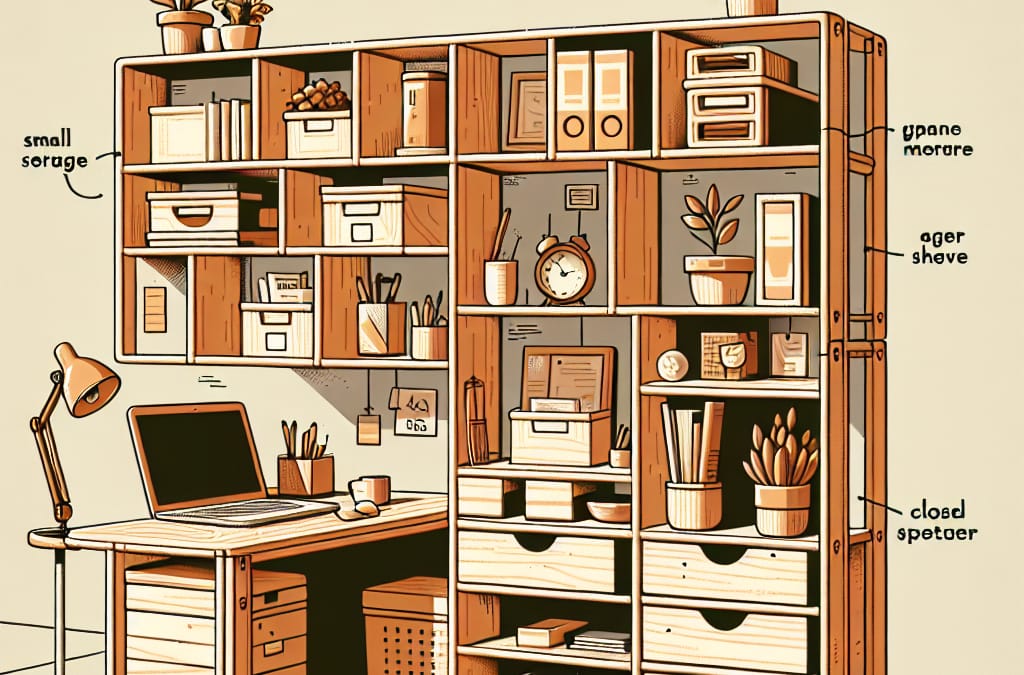Looking to create your own home office space without breaking the bank? Look no further, because Emily Carter, our Chief Content Strategist and expert in home office design, has got you covered. With her deep understanding of ergonomic principles, she not only guides you on how to design a comfortable and productive workspace but also provides detailed product reviews, DIY solutions, and promotes sustainable practices. Emily’s articles, written in a friendly and engaging tone, offer practical tips and step-by-step guides, making complex topics easily understandable. Combined with visually rich content and audience engagement, her articles are the go-to resource for anyone looking to enhance their home office setup. So, can you build your own home office shelving affordably? Let’s find out.
Understanding the Need for Home Office Shelving
Importance of organization in a home office
As someone who has worked from home for many years, I understand firsthand the importance of organization in a home office. A cluttered and disorganized workspace can negatively impact productivity and create unnecessary stress. Having dedicated shelves in your home office can help you keep essential items within reach while maintaining a clean and organized environment.
Benefits of having dedicated shelves in your workspace
Having dedicated shelves in your workspace offers numerous benefits. Firstly, it allows you to keep your office supplies, books, and other materials organized and easily accessible. No more digging through piles of papers or searching for misplaced items! Additionally, having shelves provides a sense of structure and order, which can help improve focus and concentration. It also eliminates the need for bulky file cabinets or storage containers, freeing up valuable floor space in your home office.
Determining your specific shelving needs
Before embarking on any DIY project, it is crucial to determine your specific shelving needs. Take a moment to assess the items that you need to store and consider their sizes and weight. This will help you determine the dimensions and weight capacity your shelves should have. Additionally, think about the layout and design of your home office and how the shelves will fit into the overall aesthetic. By understanding your specific shelving needs, you can ensure that your DIY project will be both functional and visually appealing.

Planning Your DIY Home Office Shelving
Assessing the available space
Before diving into your DIY home office shelving project, it is essential to assess the available space in your workspace. Measure the dimensions of the area where you plan to install the shelves, taking into account any obstacles such as windows, doors, or electrical outlets. This will give you a clear understanding of the amount of space you have to work with and help you determine the size and layout of your shelves.
Establishing an estimated budget
Budgeting is a crucial step in any DIY project, including building your own home office shelves. Determine how much you are willing to spend on materials, tools, and any additional items needed for the project. By establishing an estimated budget, you can make informed decisions when choosing materials and avoid overspending.
Choosing a design that suits your office aesthetic
When planning your DIY home office shelving, consider the design and aesthetic of your workspace. Do you prefer a minimalist look or a more rustic style? The design of your shelves should complement the overall theme of your home office and add to its visual appeal. Take inspiration from interior design magazines or online platforms to find a design that resonates with you.
Planning for functional allocation of each shelf
As you plan your DIY home office shelving project, it is crucial to consider the functional allocation of each shelf. Determine what items will be stored on each shelf and the specific purpose it will serve. For example, one shelf may be dedicated to holding books and reference materials, while another may be designated for storage bins or baskets for office supplies. By planning for the functional allocation of each shelf, you can ensure that your shelves will serve your specific needs and optimize your workspace.
Exploring Affordable Shelf Material Options
Wooden shelves
Wooden shelves are a popular choice for DIY projects due to their versatility, durability, and aesthetic appeal. They can be easily customized to fit any design preference and are available in various types of wood such as pine, oak, or plywood. However, it is important to note that wooden shelves may require more maintenance, such as regular cleaning and refinishing to protect them from moisture and wear.
Metal shelves
Metal shelves are another affordable and durable option for DIY home office shelving. They are known for their strength and sturdiness, making them ideal for storing heavier items without the risk of sagging. Metal shelves are typically made from steel or aluminum and are resistant to rust and corrosion. However, they may not offer as much aesthetic appeal as wooden shelves.
Glass shelves
For those looking for a sleek and modern look, glass shelves are an excellent option. They add a touch of elegance to any home office and create an illusion of spaciousness. Glass shelves are typically made from tempered glass, which is stronger and safer than regular glass. However, they may not be suitable for storing heavy items, as glass can be prone to cracking or shattering under excessive weight.
Composite/Plastic shelves
Composite or plastic shelves are an affordable and practical option for DIY home office shelving. They are lightweight, easy to clean, and resistant to moisture and staining. Composite shelves are typically made from a combination of wood fibers and resin, while plastic shelves are made from high-density polyethylene (HDPE) or polypropylene (PP). However, it is important to note that plastic shelves may not be as durable as other materials and may not offer the same level of customization.
Pros and cons of each material
Each material option for DIY home office shelving has its own advantages and disadvantages. Wooden shelves offer versatility and aesthetic appeal but may require more maintenance. Metal shelves are durable and sturdy but may lack aesthetic appeal. Glass shelves provide a modern and elegant look but may not be suitable for heavy items. Composite or plastic shelves are affordable and easy to clean but may not be as durable or customizable. Consider your specific needs and preferences when choosing the material for your DIY shelves to ensure they meet your requirements.





